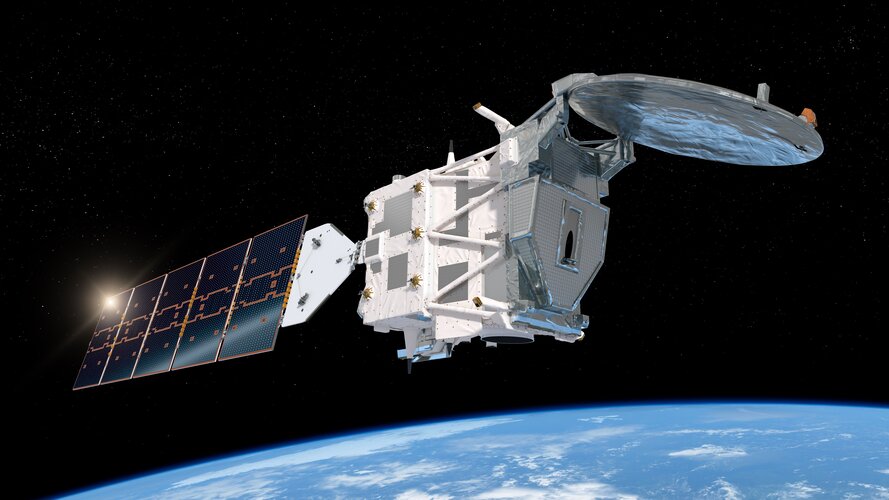EarthCARE mission kit
Friday, 17 May 2024 05:45
Explore this mission kit to learn more about EarthCARE – ESA’s new mission that will shed new light on the role that clouds and aerosols play in regulating Earth’s climate.
Government revenue and AT&T direct-to-smartphone agreement lift AST SpaceMobile
Thursday, 16 May 2024 21:42

Robotic "SuperLimbs" could help moonwalkers recover from falls
Thursday, 16 May 2024 20:55 Need a moment of levity? Try watching videos of astronauts falling on the moon. NASA's outtakes of Apollo astronauts tripping and stumbling as they bounce in slow motion are delightfully relatable.
For MIT engineers, the lunar bloopers also highlight an opportunity to innovate.
"Astronauts are physically very capable, but they can struggle on the moon, where gravity is one-sixth that
Need a moment of levity? Try watching videos of astronauts falling on the moon. NASA's outtakes of Apollo astronauts tripping and stumbling as they bounce in slow motion are delightfully relatable.
For MIT engineers, the lunar bloopers also highlight an opportunity to innovate.
"Astronauts are physically very capable, but they can struggle on the moon, where gravity is one-sixth that OCCAR and MBDA begin HYDIS2 concept phase
Thursday, 16 May 2024 20:55 MBDA has signed an agreement with the Organisation for Joint Armament Cooperation (OCCAR) on behalf of the partners of the HYpersonic Defence Interceptor Study (HYDIS2) Consortium. The European Defence Fund grant agreement and a Linked Procurement Contract were signed on May 15, launching the HYDIS2 concept phase.
The European Commission selected the HYDIS2 project for funding in July 2023
MBDA has signed an agreement with the Organisation for Joint Armament Cooperation (OCCAR) on behalf of the partners of the HYpersonic Defence Interceptor Study (HYDIS2) Consortium. The European Defence Fund grant agreement and a Linked Procurement Contract were signed on May 15, launching the HYDIS2 concept phase.
The European Commission selected the HYDIS2 project for funding in July 2023 Magic Lane secures 3 million euro to enhance location intelligence capabilities
Thursday, 16 May 2024 20:55 Magic Lane, a leader in mapping and location services, has secured a euro 3 million investment to enhance its navigation technologies for micro-mobility and IoT applications. "With this investment, we can truly accelerate our efforts to transform the location industry," explained Raymond Alves of Magic Lane. "With our solutions, we address the evolving needs of the IoT and micro-mobility market
Magic Lane, a leader in mapping and location services, has secured a euro 3 million investment to enhance its navigation technologies for micro-mobility and IoT applications. "With this investment, we can truly accelerate our efforts to transform the location industry," explained Raymond Alves of Magic Lane. "With our solutions, we address the evolving needs of the IoT and micro-mobility market Transforming iron-based alloys into advanced thermoelectric materials with brief heat treatment
Thursday, 16 May 2024 20:55 Researchers from the National Institute for Materials Science (NIMS) and Nagoya University have developed a method to convert iron-based amorphous alloys, commonly used in soft magnets, into efficient thermoelectric materials. This conversion is achieved through a brief, three-minute heat treatment, introducing a method to manipulate materials at the microstructural level for improved energy con
Researchers from the National Institute for Materials Science (NIMS) and Nagoya University have developed a method to convert iron-based amorphous alloys, commonly used in soft magnets, into efficient thermoelectric materials. This conversion is achieved through a brief, three-minute heat treatment, introducing a method to manipulate materials at the microstructural level for improved energy con Webinar Replay – Space Loves AI: How AI promises to transform space operations
Thursday, 16 May 2024 19:11

Q&A: Stellar insights—the Mauve mission's journey into the cosmos
Thursday, 16 May 2024 19:01

In a quest to study the variety of stars in our galaxy, the Mauve mission has emerged to provide a stronger understanding of the characteristics of stars—including their magnetic activity, flare evolution, and influence on the habitability of neighboring exoplanets. Chuanfei Dong, an assistant professor of astronomy within Boston University's College of Arts and Sciences, is the lead Principal Investigator (PI) at BU for the Mauve mission.
"Mauve" refers to the UV satellite provided by Blue Skies Space that scientists will utilize in a multi-year collaborative survey program, which is slated to commence mission operations in 2025. The satellite will be instrumental in providing scientists with a rare chance to re-examine and analyze active stars, which have been beyond reach since observations ceased as early as 2013 with the Galaxy Evolution Explorer (GALEX).
In this Q&A, Dr. Dong shares his insights on the mission's objectives, technological innovations, and the potential implications for our understanding of stars and exoplanet habitability.
What inspired you to pursue research in your field, and how does your involvement in the Mauve mission align with your research interests? What aspect of the Mauve mission are you particularly excited for?
Inversion Space targets military market with ‘warehouses in space’
Thursday, 16 May 2024 18:00

ESA and NASA join forces to land Europe’s rover on Mars
Thursday, 16 May 2024 16:00Press Release N° 24–2024
ESA and NASA are consolidating their cooperation on the ExoMars Rosalind Franklin mission with an agreement that ensures important US contributions, such as the launch service, elements of the propulsion system needed for landing on Mars and heater units for the Rosalind Franklin rover.
Boeing Starliner launch delayed to Tuesday due to helium leak
Thursday, 16 May 2024 14:27 Boeing's Starliner flight to the International Space Station was delayed again due to a helium leak.
NASA, Boeing and the United Launch Alliance said in a statemen Tuesday that the launch date will now come no earlier than Tuesday at 4:43 p.m. EDT.
"Starliner teams are working to resolve a small helium leak detected in the spacecraft's service module traced to a flange on a singl
Boeing's Starliner flight to the International Space Station was delayed again due to a helium leak.
NASA, Boeing and the United Launch Alliance said in a statemen Tuesday that the launch date will now come no earlier than Tuesday at 4:43 p.m. EDT.
"Starliner teams are working to resolve a small helium leak detected in the spacecraft's service module traced to a flange on a singl NASA's Juno captures detailed images of Europa's surface
Thursday, 16 May 2024 14:27 NASA's Juno spacecraft has provided high-definition images of Jupiter's moon Europa, supporting the theory that the icy crust at the poles has shifted. A new image shows signs of potential plume activity and ice shell disruption.
The findings were published in the Planetary Science Journal and JGR Planets.
On September 29, 2022, Juno flew within 220 miles of Europa's surface, capturi
NASA's Juno spacecraft has provided high-definition images of Jupiter's moon Europa, supporting the theory that the icy crust at the poles has shifted. A new image shows signs of potential plume activity and ice shell disruption.
The findings were published in the Planetary Science Journal and JGR Planets.
On September 29, 2022, Juno flew within 220 miles of Europa's surface, capturi Earth-sized planet discovered orbiting ultra-cool red dwarf star
Thursday, 16 May 2024 14:27 An international team of astronomers has detected a new Earth-sized planet orbiting an ultra-cool red dwarf star, located 55 light years away.
The planet, named SPECULOOS-3 b, is the second of its kind discovered around this type of star. It completes an orbit of the star in about 17 hours. The star is more than twice as cold as our sun and significantly less massive and luminous.
SP
An international team of astronomers has detected a new Earth-sized planet orbiting an ultra-cool red dwarf star, located 55 light years away.
The planet, named SPECULOOS-3 b, is the second of its kind discovered around this type of star. It completes an orbit of the star in about 17 hours. The star is more than twice as cold as our sun and significantly less massive and luminous.
SP Newly discovered Earth-sized planet may lack an atmosphere
Thursday, 16 May 2024 14:27 Astronomers at MIT, the University of Liege, and elsewhere have discovered a new planet orbiting a small cold star, a mere 55 light years away. The nearby planet is similar to Earth in its size and rocky composition, though that's where the similarities end. Because this new world is likely missing an atmosphere.
In a paper appearing in Nature Astronomy, the researchers confirm the detecti
Astronomers at MIT, the University of Liege, and elsewhere have discovered a new planet orbiting a small cold star, a mere 55 light years away. The nearby planet is similar to Earth in its size and rocky composition, though that's where the similarities end. Because this new world is likely missing an atmosphere.
In a paper appearing in Nature Astronomy, the researchers confirm the detecti ATT and AST SpaceMobile Sign Agreement for Satellite Broadband Network
Thursday, 16 May 2024 14:27 ATT and AST SpaceMobile have finalized a commercial agreement to create a space-based broadband network for cell phones, effective until 2030. Previously, the companies collaborated under a Memorandum of Understanding. This marks significant progress towards improved connectivity for consumers and businesses nationwide.
This summer, AST SpaceMobile plans to launch its first commercial sate
ATT and AST SpaceMobile have finalized a commercial agreement to create a space-based broadband network for cell phones, effective until 2030. Previously, the companies collaborated under a Memorandum of Understanding. This marks significant progress towards improved connectivity for consumers and businesses nationwide.
This summer, AST SpaceMobile plans to launch its first commercial sate 
